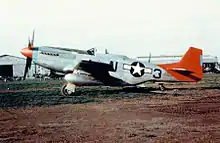John Ellis Edwards
Lt. Col John "Ellis" Edwards (May 17, 1922 – June 3, 1979)[1] was a member of the famed group of World War II-era African-Americans known as the Tuskegee Airmen. He was a recipient of the Congressional Gold Medal in 2007.[2] Edwards served in the 332nd Fighter Group and earned the Distinguished Flying Cross award.[3] He also served as a pilot in the Korean War.[4]
John Ellis Edwards | |
|---|---|
 John "Ellis" Edwards in a WWII era photo | |
| Nickname(s) | Ellis |
| Born | May 17, 1922 Steubenville, Ohio |
| Died | June 3, 1979 (aged 57) Steubenville, Ohio |
| Buried | Union Cemetery (40.368088°N 80.633455°E) |
| Allegiance | |
| Service/ | United States Army Air Force |
| Years of service |
|
| Rank |
|
| Unit | |
| Awards | |
| Relations | Brother Jerome Edwards |
Military service
World War II

.jpg.webp)
His brother Jerome Edwards was a pilot in the Tuskegee Airmen and was killed in a training exercise May 7, 1943 when his P-40 suffered a catastrophic failure upon takeoff.[3] His brother's death was the first for the 332nd Fighter Group.[4]
After graduating from West Virginia State College and completing WVSC's civilian pilot program, John Ellis Edwards went to Tuskegee where he became a pilot and was assigned to the 99th Fighter Squadron, 332nd Fighter Group. He graduated from Tuskegee and was commissioned as a 2nd Lieutenant April 8, 1944. In 1945 he was sent to Italy and assigned to Ramitelli Air Force Base where he and other Tuskegee pilots escorted allied planes on bombing runs. On April 1, 1945 he was acting as squadron section leader, when he shot down two enemy ME-109’s on an escort mission. Edwards was awarded Distinguished flying Cross.[4][3]
Shortly after he was discharged the Korean War began. Edwards joined the Air Force and flew many combat missions in a F86 Sabre.[4] He held the rank of Lieutenant Colonel.[7]
Edwards hometown, Steubenville, OH is known as the "City of Murals". There is a mural (located along Washington Street in Steubenville) dedicated to John Ellis Edwards and his brother Jerome Edwards. Both were Tuskegee airmen.[3] He and his brother also have their names engraved in the Tuskegee Airmen Memorial located in Sewickley Cemetery in Sewickley, Pennsylvania.[8]
Awards
- Congressional Gold Medal (2007)[2]
- Distinguished Flying Cross
- Air Medal[4]
- Presidential Unit Citation[4]
Education
- Steubenville High School[4]
- West Virginia State College[4]
Personal life
Edward and Willie Edwards were his parents.[9] He had a brother (Jerome) and sister (Gwendolyn). His parents moved to Steubenville, Ohio and he and his siblings attended Steubenville High School.[10]
After high school graduation John Ellis Edwards and his brother Jerome Edwards both attended Virginia State College. The college became one of the first black colleges to enroll pilots in a Pilot Training Program and both brothers enrolled in the program. Both brothers became Tuskegee Airmen after completing training in Tuskegee.[4]
He rejoined the Air Force during the Korean War, and served in the 332nd Fighter Group. After the Korean War he moved to Washington, D.C., and later he moved to Los Angeles, California.[10]
Further reading
- The Tuskegee Airmen: An Illustrated History, 1939–1949[11]
- "Born to Fly the Skies." Weirton Daily Times (Weirton, W.Va.) 23 February 2013. Web. 17 January 2014.
- "Tuskegee Airmen Pilot Listing." Tuskegee University, 2014, Web. 17 January 2014.
References
- "Union Cemetery – Burial Records Steubenville, Jefferson County, Ohio". interment.net. Clear Digital Media, Inc. Retrieved August 10, 2020.
- Rangel, Charles B. (April 11, 2006). "Tuskegee Airmen Gold Medal Signed Into Law". Press Release. United States House of Representatives. Retrieved November 26, 2008.
- "Legacy of 2 Tuskegee Airmen From Steubenville Honored". The Intelligencer Wheeling News. May 9, 2020. Retrieved August 10, 2020.
- "Profile of Tuskegee Airmen brothers Jerome and John "Ellis" Edwards". CAF Rise Above. CAF Rise Above. Retrieved August 10, 2020.
- Rice, Markus. "The Men and Their Airplanes: The Fighters." Tuskegee Airmen, 1 March 2000.
- "MiG-15 'Fagot'." Archived 27 July 2011 at the Wayback Machine mnangmuseum.org. Retrieved: 19 July 2011.
- "13 March 2020 MDVA News and Announcements". govdelivery.com. Maryland Department of Veterans Affairs. Retrieved August 10, 2020.
- "The Tuskegee Airmen Memorial". Sewickley Cemetery. webCemeteries.com. Retrieved August 10, 2020.
- "Tuskegee Airmen". findagrave.com. Find a Grave. Retrieved August 10, 2020.
- "John Ellis Edwards Air Force and family photograph albums ([1940s]-1973)". University of Michigan. U-M Library. Retrieved August 10, 2020.
- Caver, Joseph; Ennels, Jerome A.; Haulman, Daniel Lee (2011). The Tuskegee Airmen: An Illustrated History, 1939–1949. Montgomery: New South Books. p. 394. ISBN 978-1588382443. Retrieved February 6, 2020.
Notes
- The red markings that distinguished the Tuskegee Airmen included red bands on the noses of P-51s as well as a red rudder; their P-51B and D Mustangs flew with similar color schemes, with red propeller spinners, yellow wing bands and all-red tail surfaces.[5]
- The North American F-86 Sabre, sometimes called the Sabrejet, is a transonic jet fighter aircraft. Produced by North American Aviation, the Sabre is best known as the United States' first swept-wing fighter that could counter the swept-wing Soviet MiG-15 in high-speed dogfights in the skies of the Korean War (1950–1953).[6]
External links
- Tuskegee Airmen at Tuskegee University
- Tuskegee Airmen Archives at the University of California, Riverside Libraries.
- Tuskegee Airmen, Inc.
- Tuskegee Airmen National Historic Site (U.S. National Park Service)
- Tuskegee Airmen National Museum
- Fly (2009 play about the 332d Fighter Group)

